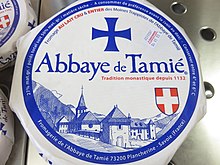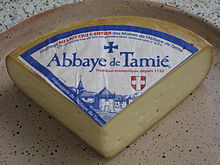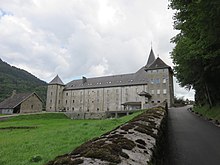Abbaye de Tamié
The Abbaye de Tamié is a French semi-soft cheese from raw milk . It is made exclusively in the Tamié monastery , from which it takes its name.
properties
The Abbaye de Tamié is a semi-hard semi-hard cheese made from raw milk , which looks similar to the Reblochon . The loaf is disc-shaped with a slightly convex edge and has a beige to saffron-yellow thin, leathery rind with a very light coating of white noble mold. The yellowish dough has only a few pea- to bean-sized holes. The taste of the young cheese is nutty and mild, with increasing maturity it develops a full and strong taste.
The cheese is offered in two sizes, the Tamié Petit Modèle or Petit Tamié with 580 to 600 grams and the Tamié Grand Modèle or Grand Tamié with 1400 to 1600 grams. While the small loaf is usually sold whole, the Grand Tamié is also available sliced. The cheese wheels are wrapped in white paper with a characteristic blue paw cross and information about the product.
The Abbaye de Tamié is preferably served on a cheese platter . A light and fruity red, white or rosé wine from Savoie , such as an Apremont, a Mondeuse Noire or a Mondeuse Blanche, goes well with it .
history
The Tamié monastery, now inhabited by Trappists , was founded by the Cistercians in 1133 on land that was donated to the order the previous year. According to tradition, the Abbaye de Tamié, named after the monastery, was produced from the first year. The original cheese is said to have been similar to Gruyère , the recipe was lost during the French Revolution . When the Cistercians returned in 1861 to rebuild the monastery, they found most of the pastures around the monastery deserted. They had to develop a cheese that could be made with the now smaller milk supply. Based on a recipe for Port Salut , they created the Abbaye de Tamié as a smaller and faster maturing cheese.
Since 1861 the production process in the monastery cheese dairy has been improved again and again. As a result, the Tamié Monastery has one of the most successful monastic cheese dairies in Europe. More than half of the approximately 70 friars in the monastery are engaged in cheese-making in various ways. The cheese dairy is the monastery’s main source of income.
Manufacturing
The Abbaye de Tamié is made exclusively in the cheese dairy of the Tamié monastery in the municipality of Plancherine , Savoie department, from raw cow's milk from eight farms in the immediate vicinity. The cows are kept in the pasture in summer and fed on hay and grain in winter, grown by some of the farmers themselves. Silage is not fed.
The manufacturing process is now largely automated and the monastery controls all production steps from quality management of milk production to the generation of biogas from whey . Particular emphasis is placed on bacteriologically perfect milk, the 4.2 cubic meters of raw milk are collected from the farmers every day in order to obtain the freshest possible raw material.
The raw milk, heated to 34 ° C in copper kettles, is given a small amount of a specific starter culture. The rennet is added after 90 minutes . When the milk is concentrated the mass is a cheese harp cut and the bean-sized fraction in perforated cylindrical cheese molds filled. The curd is pressed in it for three to five hours and turned over repeatedly. Then, depending on the size, the loaves are dipped in brine for one to three hours.
The cheese wheels ripen in the vaulted cellars of the monastery, where the humidity is 85 to 90 percent and the temperature is constant at around 14 ° C. The ripening process requires frequent washing and turning of the loaves and takes up to 40 days. Around 400 kilograms are produced every day.
Web links
- La fromagerie de Tamié , website of the cheese dairy (French)
- Au fil de l'histoire de l'Abbaye de Tamier et de son fromage , video from France 3 Auvergne-Rhône-Alpes on YouTube (3:13 min., French)
supporting documents
- ↑ a b c d e Soyoung Scanlan: Abbaye de Tamié . In: Catherine Donnelly (Ed.): The Oxford Companion to Cheese . Oxford University Press, Oxford 2016, ISBN 978-0-19-933088-1 , pp. 1 .
- ↑ a b Juliet Harbutt (Ed.): World Cheese Book . Dorling Kindersley, London a. a. 2009, ISBN 978-0-7566-5442-9 , pp. 31 .
- ↑ a b c d La fromagerie de Tamié. In: Tamié Monastery . Retrieved January 16, 2020 (French).



